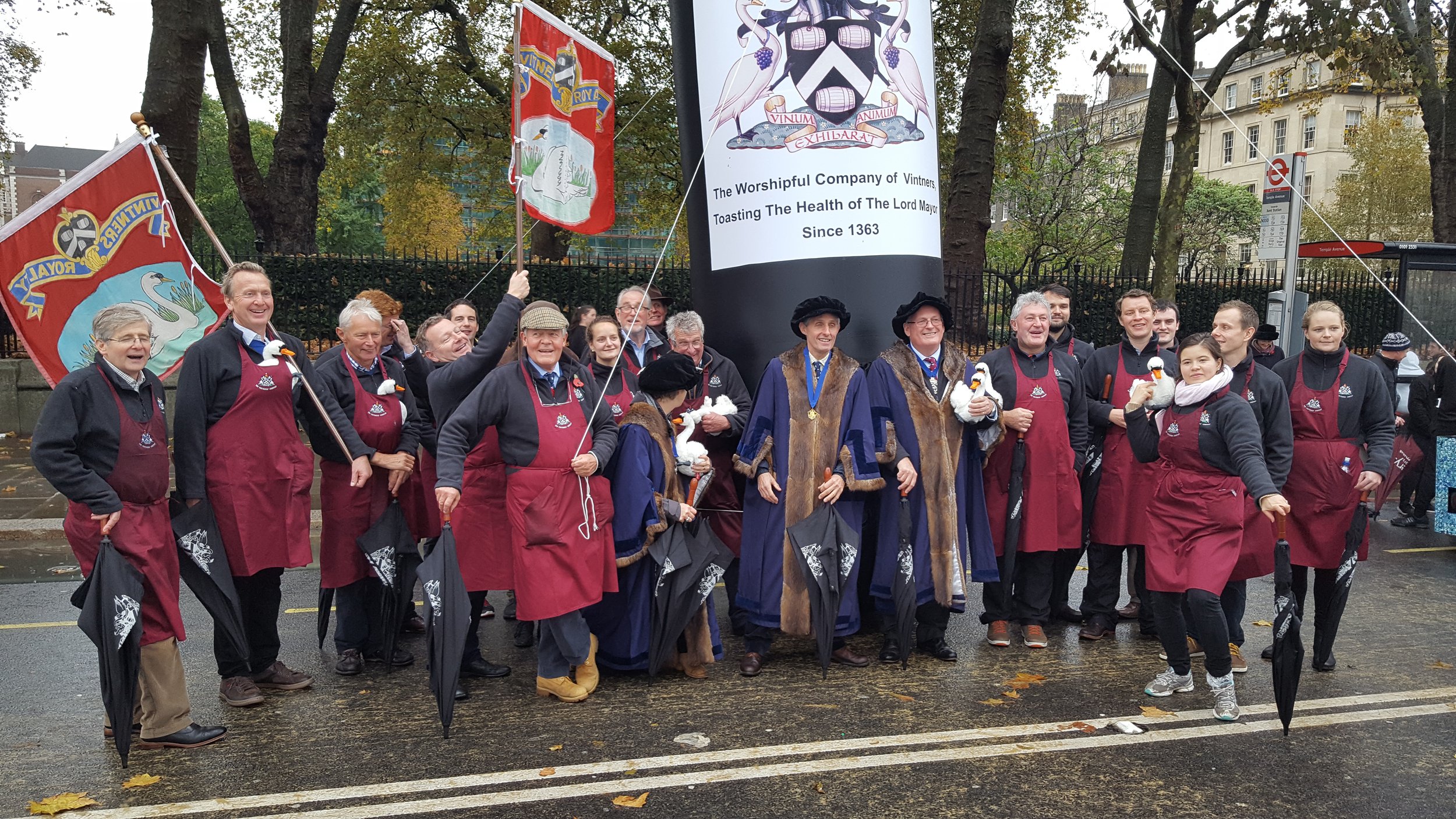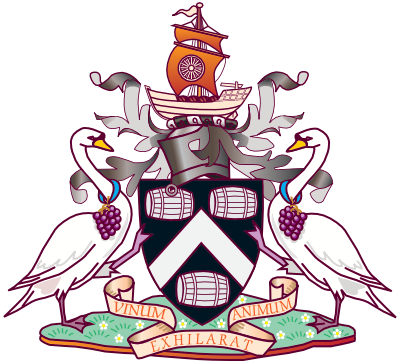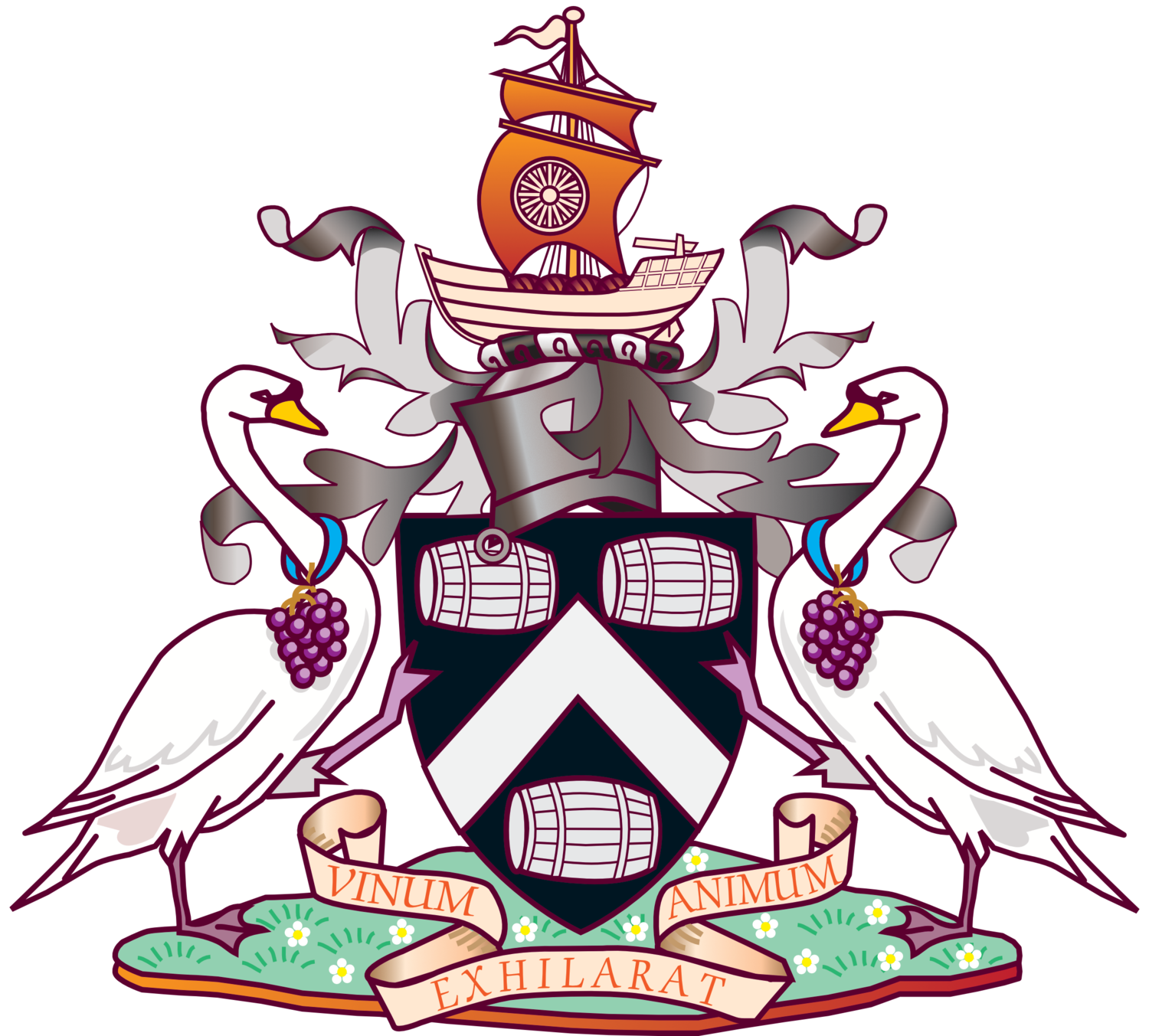The Vintners’ Company and the City of London Corporation
Introduction by Alderman Dr Sir Andrew Parmley
(Lord Mayor of the City of London 2016-2017 and Master Vintner 2018-2019)
The City of London Corporation is the oldest, continuous metropolitan local authority in the world. It is governed by the Lord Mayor, two Sheriffs, twenty-five Aldermen, one hundred Common Councilmen and approximately four thousand staff. While the Aldermen and Common Councillors are elected democratically by the voters in the twenty-five historic Wards, the Sheriffs and Lord Mayor are elected by the Liverymen of the City when Common Hall assembles twice each year.
As head of the Corporation, the Lord Mayor chairs meetings of Common Council in Guildhall and has a wide range of responsibilities in London and across the United Kingdom as a key representative of financial services (500,000 workers in the City and 2.2 million across the British Isles) and as the Head of the Livery. Many Liverymen will be familiar with the pageantry and spectacle of the Lord Mayor’s Show and Banquet and most will have seen the Lord Mayor attending functions in a variety of historic outfits. But there is much more to the role than that.
The main work of the Lord Mayor goes on overseas and out of sight. The (unremunerated) job is to promote the UK’s financial and professional services, creating opportunities for investment overseas and opportunities for overseas investors to invest through the UK. London remains the financial centre of the world, clearing more Euros every day than the twenty-seven member countries of the EU combined and more dollars than New York.
In the fourteenth century Vintry Ward was the wealthiest Ward in the City, and adjacent to our Hall, wine, herbs, spices, garlic and furs would have been unloaded from every corner of the world. The shippers would leave with cargoes of wool to ensure the return journey was also profitable. We are now proud of the cosmopolitan nature of the City. In Chaucer’s time (incidentally, the father of English poetry was the son of a Vintner and he was born a stone’s throw from the Hall) the second language in the Ward was French. The City was – and is – a vibrant, thrilling melting pot, a meritocracy of the first order, as Richard Whittington once discovered.
(Lord Mayor of the City of London 2016-2017 and Master Vintner 2018-2019)
The City of London Corporation is the oldest, continuous metropolitan local authority in the world. It is governed by the Lord Mayor, two Sheriffs, twenty-five Aldermen, one hundred Common Councilmen and approximately four thousand staff. While the Aldermen and Common Councillors are elected democratically by the voters in the twenty-five historic Wards, the Sheriffs and Lord Mayor are elected by the Liverymen of the City when Common Hall assembles twice each year.
As head of the Corporation, the Lord Mayor chairs meetings of Common Council in Guildhall and has a wide range of responsibilities in London and across the United Kingdom as a key representative of financial services (500,000 workers in the City and 2.2 million across the British Isles) and as the Head of the Livery. Many Liverymen will be familiar with the pageantry and spectacle of the Lord Mayor’s Show and Banquet and most will have seen the Lord Mayor attending functions in a variety of historic outfits. But there is much more to the role than that.
The main work of the Lord Mayor goes on overseas and out of sight. The (unremunerated) job is to promote the UK’s financial and professional services, creating opportunities for investment overseas and opportunities for overseas investors to invest through the UK. London remains the financial centre of the world, clearing more Euros every day than the twenty-seven member countries of the EU combined and more dollars than New York.
In the fourteenth century Vintry Ward was the wealthiest Ward in the City, and adjacent to our Hall, wine, herbs, spices, garlic and furs would have been unloaded from every corner of the world. The shippers would leave with cargoes of wool to ensure the return journey was also profitable. We are now proud of the cosmopolitan nature of the City. In Chaucer’s time (incidentally, the father of English poetry was the son of a Vintner and he was born a stone’s throw from the Hall) the second language in the Ward was French. The City was – and is – a vibrant, thrilling melting pot, a meritocracy of the first order, as Richard Whittington once discovered.
Photo: Sir Andrew Parmley in the state coach - picture courtesy Clive Totman

The Lord Mayor’s Show - Saturday 12 November 2016
These featured videos are taken from the Lord Mayor's show on Saturday 12 November 2016 following Sir Andrew's admission as Lord Mayor on Friday 11 November 2016.
Livery Companies and the City of London
All livery companies come under an element of control by the City of London's Court of Aldermen. To become a new company, a group of people (usually numbering at least 100) must satisfy the Court that they have the resources and willingness to continue their association indefinitely, having already been long and well established. In addition to strong ties with the Square Mile, the potential new Company must have a significant number of members engaged in its particular trade, profession or craft, which must not overlap or clash with that of an existing guild.
Liverymen still play a pivotal role in the election of the Lord Mayor.
In 1385, a regulation was introduced requiring each Lord Mayor to have previously served as a Sheriff and, until 1742, to be a member of one of the 12 senior livery companies (the Great Twelve). Today, each Lord Mayor will still belong to one of the City livery companies, and be supported by their fellow liverymen in Common Hall at the end of September each year.
The Lord Mayor will also be an Alderman, whose Court oversees the creation and conduct of the livery companies. Aldermen are elected by the Square Mile's 25 Wards. The City's franchise gives voting rights to a wide representation of organisations within the Square Mile enabling nominees or representatives of livery companies occupying premises there to be voters.
The livery companies also play a prominent role in many great occasions. Each year’s United Guilds’ Service in St Paul’s sees the livery companies, City of London and church joining together for a great ceremonial event, while the Lord Mayor's Show features spectacular displays by many livery companies, particularly those with close links to the new Lord Mayor and the two Sheriffs.
The livery companies and the City of London have enjoyed a long, close and extremely effective working partnership, sharing objectives, supporting excellence and together promoting the Square Mile. This partnership is fostered through a dedicated committee, the Livery Committee, which strengthens these ties, as well as constantly seeking new ways to enhance joint initiatives for the future.
source: https://www.cityoflondon.gov.uk/about-us/law-historic-governance/livery-companies
Liverymen still play a pivotal role in the election of the Lord Mayor.
In 1385, a regulation was introduced requiring each Lord Mayor to have previously served as a Sheriff and, until 1742, to be a member of one of the 12 senior livery companies (the Great Twelve). Today, each Lord Mayor will still belong to one of the City livery companies, and be supported by their fellow liverymen in Common Hall at the end of September each year.
The Lord Mayor will also be an Alderman, whose Court oversees the creation and conduct of the livery companies. Aldermen are elected by the Square Mile's 25 Wards. The City's franchise gives voting rights to a wide representation of organisations within the Square Mile enabling nominees or representatives of livery companies occupying premises there to be voters.
The livery companies also play a prominent role in many great occasions. Each year’s United Guilds’ Service in St Paul’s sees the livery companies, City of London and church joining together for a great ceremonial event, while the Lord Mayor's Show features spectacular displays by many livery companies, particularly those with close links to the new Lord Mayor and the two Sheriffs.
The livery companies and the City of London have enjoyed a long, close and extremely effective working partnership, sharing objectives, supporting excellence and together promoting the Square Mile. This partnership is fostered through a dedicated committee, the Livery Committee, which strengthens these ties, as well as constantly seeking new ways to enhance joint initiatives for the future.
source: https://www.cityoflondon.gov.uk/about-us/law-historic-governance/livery-companies
City Courses for Members of the Vintners’ Company
The Livery Committee runs a variety of courses which provide information on how the City of London Corporation works, the range of its activities, some key issues facing the City, and how Liverymen can get involved in City affairs. They also act as a forum for discussion and an opportunity for informal networking.
The short 'City Briefings' courses are aimed particularly at new Liverymen and Freemen; partners are also welcome, as are Court Assistants and Liverymen of longer standing, who have not previously been to a Briefing.
Courses are in the evening at Guildhall and last about 90 minutes. They give a short introduction to the work of the Corporation, especially the relationship with the livery companies. The presentation is given by an Assistant Town Clerk and a member of the Livery Committee. There is opportunity to ask questions of the speakers and the Briefing is followed by a light finger buffet, which provides the chance to mix with other Liverymen and Freemen.
Members of the Vintners' Company are encouraged to attend one of the City Briefing courses.
For more information and to book your course, please click the image below. The Company will reimburse the cost of the course upon submission of a receipt.
The short 'City Briefings' courses are aimed particularly at new Liverymen and Freemen; partners are also welcome, as are Court Assistants and Liverymen of longer standing, who have not previously been to a Briefing.
Courses are in the evening at Guildhall and last about 90 minutes. They give a short introduction to the work of the Corporation, especially the relationship with the livery companies. The presentation is given by an Assistant Town Clerk and a member of the Livery Committee. There is opportunity to ask questions of the speakers and the Briefing is followed by a light finger buffet, which provides the chance to mix with other Liverymen and Freemen.
Members of the Vintners' Company are encouraged to attend one of the City Briefing courses.
For more information and to book your course, please click the image below. The Company will reimburse the cost of the course upon submission of a receipt.



